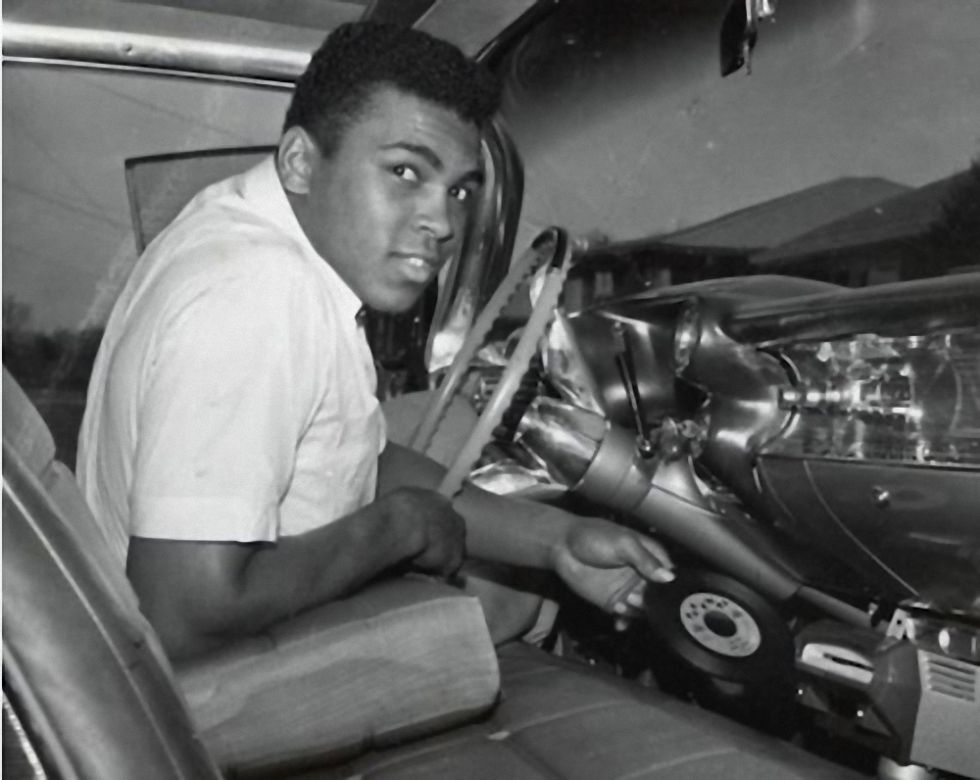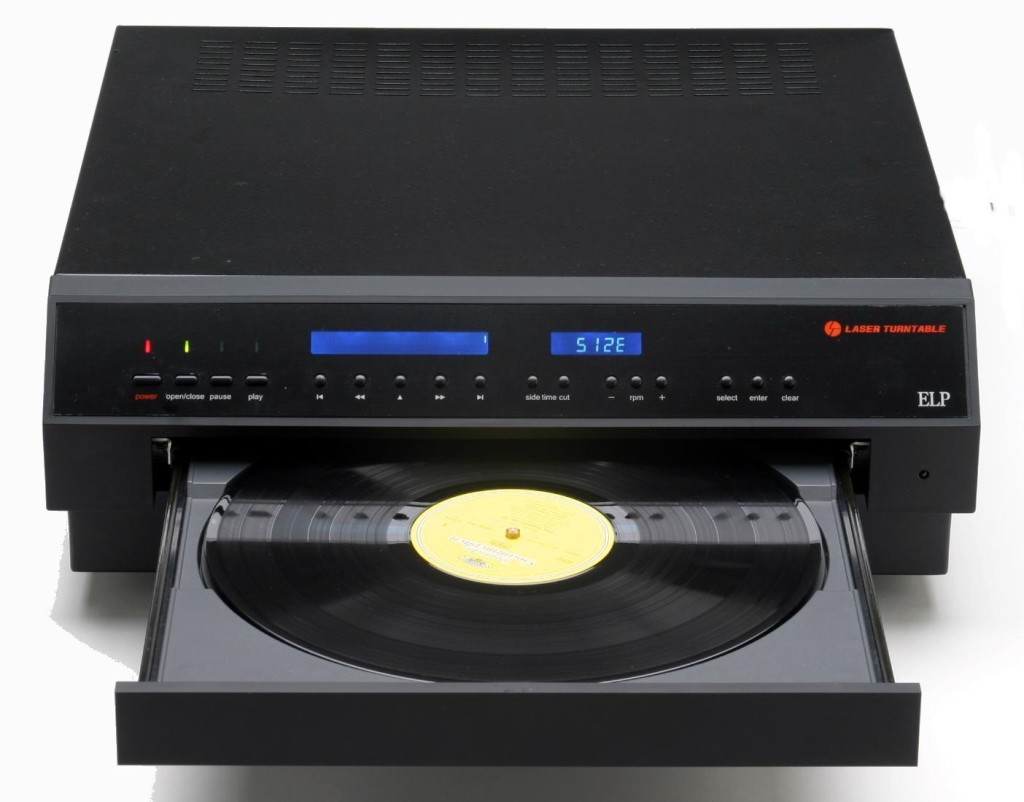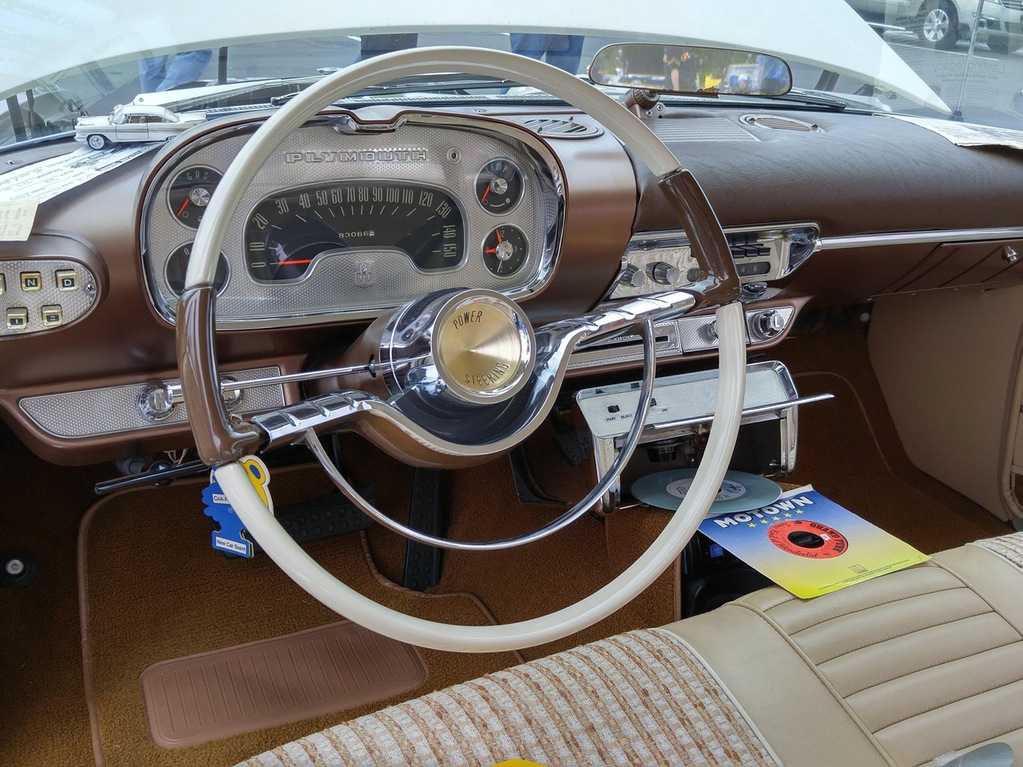The history of vinyl in the car
Greetings from the 50s of the last century

What do George Harrison from The Beatles, boxing legend Mohammed Ali and Chrysler cars have in common? The answer is that they all somehow have to do with the Highway Hi-Fi portable turntable, which was installed by Chrysler on some of their car models 60 years ago. It first appeared in 1956 and for those times it was something special. The device is innovative for its time, high-tech, plus it's music, which is so necessary for motorists on the road. Highway Hi-Fi seemed doomed to success.
')
Regular car radio is the need to put up with the musical tastes of a leading radio station, which is located tens of kilometers from the car, and which you can’t ask you to put your favorite track from a car that has no fixed or cellular telephone connection. And Highway Hi-Fi allowed you to listen to exactly the music that you like. A full hour and a half of your favorite music is two times more than the standard vinyl record of the time! Yes, for Highway Hi-Fi produced vinyl discs of its own format. The trick was simple - the disc playback speed was reduced by the manufacturer to 16.66 revolutions per minute. This is much less than a regular turntable.
A technological marvel, no more and no less. Unfortunately, something went wrong, and Highway Hi-Fi was removed from production only a year after it was released to the market. What happened? Definitely, system designer Peter Goldmark tried his best. He created the long-playing records, adding a new standard to the existing one. It was also easy to produce records for the player - there were no technological problems. The package of delivery of such a player (or rather, a car - the system was not sold separately) included six plates. But where to get the other records after listening to these? This was the main problem.

It was not at all in technology and not in the quality of music reproduction, but with the popularity of the standard and the prevalence of media. Sony faced a similar problem, developing the Betamax standard 25 years after entering the Highway Hi-Fi market. Developing a new standard is not enough - you need someone else to use it. In the case of Betamax, the problem was that Sony simply could not agree with the leading content providers - the film studios refused to work with the new standard. As a result, won the standard VHS, which has become almost the only one on the market. True, Betamax was also used, and the cassettes of this standard were produced for a long time, but almost individually. About any mass production and the speech was not.
As for Highway Hi-Fi, then this format had almost no competitors at the time of its appearance. It would seem that you can develop and develop. But in fact, the specific format did not give the player a lot of choices. Motorists' musical tastes are very different, and the choice of music from Highway Hi-Fi was minimal. Lovers of good music simply could not bring their own record in the car and put your favorite music. It was necessary to wait until the corresponding record appears - and this, as they say, is a long song. Plus, the Highway Hi-Fi players were equipped only with Chrysler cars, that is, the number of users of the players with the support of the new standard was so scanty that the recording studios simply had no reason to produce new types of records - the profit from such a business was zero. In other words, motorists simply could not find new records of a specific format. Why do we need a player without a record?

Plus, the players were proprietary, installed in a factory. If something broke, it was difficult to fix it yourself.

A couple of years after Highway Hi-Fi was discontinued, Recording Corporation of America entered the market of vinyl car players. She offered a standard disc player with a listening speed of 45 revolutions per minute. It seemed that the problem was solved and the turntables would gradually become popular. But no - just a year after the release, and these players were removed from production. Here the problem was that 45 rev / s disks could be got anywhere and everywhere. These 7-inch records are now. But the duration of the musical composition itself is only 2-4 minutes. What does it mean? Every 2-4 minutes the driver (being in the car on the move) had to rearrange the pickup with one hand. It was both uncomfortable and dangerous. True, the safety of the drivers then worried not to say that very much. At that time, little attention was paid to public health and safety. Needless to say, even a teacher could smoke at school, smoked on buses, many car models had no head restraints on the car seats — and no one said anything. But the problem was also in the reliability of the mechanics of such players.

The point is that in vinyl car players there was a system that held the needle on the plate. This was necessary so that the music played even when the car bounces on uneven roads. Here, a special controlled pillar of the needle holder arm was used, which eliminated pushes and deviations when the vehicle was moving. The needle was held, but when it was shaken, it slightly damaged the plate itself, although it was equipped with a counterweight. The more a person drove a car, listening to the same disc - the faster the recording went down. The systems from RCA, RAC, and Allstate disc protection was not at all as reliable as the Highway Hi-Fi from Chrysler.
For a while, such devices still held out on the market - until about the end of the 60s. Some celebrities installed them in their cars, including George Harrison, Mohammed Ali, Jimi Hendrix. But already in 70-vinyl car players of any formats simply disappeared. However, not in all countries. In Spain, in 1968, its own car vinyl record player was created: Comediscos. He worked with standard records that worked at a speed of 45 rpm. This system quickly became popular - but only in Spain and Italy. The popularity of the system was maintained until the mid-70s of the last century. Philips has also developed its own player, and this system had a slit-loading disc. However, such a player has not received much distribution. By the way, in 2011, Seat announced its intention to create a vinyl car player for music lovers, although the matter did not go further than the idea.

Stationary modern turntable
After some time, there were already other car audio systems - reel, cassette, which did not have the disadvantage that was inherent in vinyl audio systems - a bouncing needle. And this is another story.


What do George Harrison from The Beatles, boxing legend Mohammed Ali and Chrysler cars have in common? The answer is that they all somehow have to do with the Highway Hi-Fi portable turntable, which was installed by Chrysler on some of their car models 60 years ago. It first appeared in 1956 and for those times it was something special. The device is innovative for its time, high-tech, plus it's music, which is so necessary for motorists on the road. Highway Hi-Fi seemed doomed to success.
')
Regular car radio is the need to put up with the musical tastes of a leading radio station, which is located tens of kilometers from the car, and which you can’t ask you to put your favorite track from a car that has no fixed or cellular telephone connection. And Highway Hi-Fi allowed you to listen to exactly the music that you like. A full hour and a half of your favorite music is two times more than the standard vinyl record of the time! Yes, for Highway Hi-Fi produced vinyl discs of its own format. The trick was simple - the disc playback speed was reduced by the manufacturer to 16.66 revolutions per minute. This is much less than a regular turntable.
A technological marvel, no more and no less. Unfortunately, something went wrong, and Highway Hi-Fi was removed from production only a year after it was released to the market. What happened? Definitely, system designer Peter Goldmark tried his best. He created the long-playing records, adding a new standard to the existing one. It was also easy to produce records for the player - there were no technological problems. The package of delivery of such a player (or rather, a car - the system was not sold separately) included six plates. But where to get the other records after listening to these? This was the main problem.

It was not at all in technology and not in the quality of music reproduction, but with the popularity of the standard and the prevalence of media. Sony faced a similar problem, developing the Betamax standard 25 years after entering the Highway Hi-Fi market. Developing a new standard is not enough - you need someone else to use it. In the case of Betamax, the problem was that Sony simply could not agree with the leading content providers - the film studios refused to work with the new standard. As a result, won the standard VHS, which has become almost the only one on the market. True, Betamax was also used, and the cassettes of this standard were produced for a long time, but almost individually. About any mass production and the speech was not.
As for Highway Hi-Fi, then this format had almost no competitors at the time of its appearance. It would seem that you can develop and develop. But in fact, the specific format did not give the player a lot of choices. Motorists' musical tastes are very different, and the choice of music from Highway Hi-Fi was minimal. Lovers of good music simply could not bring their own record in the car and put your favorite music. It was necessary to wait until the corresponding record appears - and this, as they say, is a long song. Plus, the Highway Hi-Fi players were equipped only with Chrysler cars, that is, the number of users of the players with the support of the new standard was so scanty that the recording studios simply had no reason to produce new types of records - the profit from such a business was zero. In other words, motorists simply could not find new records of a specific format. Why do we need a player without a record?

Plus, the players were proprietary, installed in a factory. If something broke, it was difficult to fix it yourself.
And now the competitors are pulled

A couple of years after Highway Hi-Fi was discontinued, Recording Corporation of America entered the market of vinyl car players. She offered a standard disc player with a listening speed of 45 revolutions per minute. It seemed that the problem was solved and the turntables would gradually become popular. But no - just a year after the release, and these players were removed from production. Here the problem was that 45 rev / s disks could be got anywhere and everywhere. These 7-inch records are now. But the duration of the musical composition itself is only 2-4 minutes. What does it mean? Every 2-4 minutes the driver (being in the car on the move) had to rearrange the pickup with one hand. It was both uncomfortable and dangerous. True, the safety of the drivers then worried not to say that very much. At that time, little attention was paid to public health and safety. Needless to say, even a teacher could smoke at school, smoked on buses, many car models had no head restraints on the car seats — and no one said anything. But the problem was also in the reliability of the mechanics of such players.

The point is that in vinyl car players there was a system that held the needle on the plate. This was necessary so that the music played even when the car bounces on uneven roads. Here, a special controlled pillar of the needle holder arm was used, which eliminated pushes and deviations when the vehicle was moving. The needle was held, but when it was shaken, it slightly damaged the plate itself, although it was equipped with a counterweight. The more a person drove a car, listening to the same disc - the faster the recording went down. The systems from RCA, RAC, and Allstate disc protection was not at all as reliable as the Highway Hi-Fi from Chrysler.
For a while, such devices still held out on the market - until about the end of the 60s. Some celebrities installed them in their cars, including George Harrison, Mohammed Ali, Jimi Hendrix. But already in 70-vinyl car players of any formats simply disappeared. However, not in all countries. In Spain, in 1968, its own car vinyl record player was created: Comediscos. He worked with standard records that worked at a speed of 45 rpm. This system quickly became popular - but only in Spain and Italy. The popularity of the system was maintained until the mid-70s of the last century. Philips has also developed its own player, and this system had a slit-loading disc. However, such a player has not received much distribution. By the way, in 2011, Seat announced its intention to create a vinyl car player for music lovers, although the matter did not go further than the idea.

Stationary modern turntable
After some time, there were already other car audio systems - reel, cassette, which did not have the disadvantage that was inherent in vinyl audio systems - a bouncing needle. And this is another story.

Source: https://habr.com/ru/post/395617/
All Articles